The Infantry Fighting Model
The challenge is to translate these new ideas about how the Romans fought into visual images of what it might have looked like. One faces several problems when trying to create a visual model. Drafting detailed images requires a lot of guesswork. It is one thing to say "they stood back from each other." It is another thing to draw it and be forced to decide if "back from" means 10 feet or 30 yards. Some of the guesswork is fairly straightforward and I will try to identify it. Other elements are more subtle, built into general understandings that might not even be fully recognized. These illustrations should be taken as ideas about how things might have looked, at best. They are attempts to visualize some aspects of current thinking about Roman fighting. They should raise more questions than they answer. They can help identify problems with proposed scenarios. But, however they are used, they should not be thought of as definitive.
This shows the two "armies" that will be used in the fighting model. Both are Roman, each composed of four legions in a triplex acies formation. The cohorts of the second line are shown positioned closer to the first line to reflect their role as support for the first line. The third line is shown held further back to act as a reserve force. The two armies are positioned about 600 feet apart. To reach this point each army would already have moved a considerable distance from their respective camps. Preliminary manoeuvring would be completed and each army would now be ready to commence fighting. The illustration below shows the spacing between the centuries. Prior and Posterior pairs of centuries are separated by six feet, pairs of centuries are separated from each other by twice that, twelve feet, and legions are separated by fifty feet. These separations are arbitrary and largely there for manoeuvre. As will be seen, once combat begins these spacings become irrelevant.
The illustration below shows the spacing between the centuries. Prior and Posterior pairs of centuries are separated by six feet, pairs of centuries are separated from each other by twice that, twelve feet, and legions are separated by fifty feet. These separations are arbitrary and largely there for manoeuvre. As will be seen, once combat begins these spacings become irrelevant.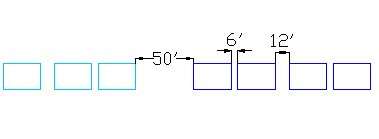 Every other legion in each army is a slightly different colour. This was done merely to help distinguish one legion from the next and has no other significance.
Why four legions? Although armies of this era were often larger than four legions, it would be too time-consuming to try to draw them with this level of detail. And, even if they were drawn, the final images would be so wide that details could not be seen. I selected four because it makes for an army that is large enough to give an idea of what the battlefield might have been like and small enough to be drafted and for details to be visible.
Every other legion in each army is a slightly different colour. This was done merely to help distinguish one legion from the next and has no other significance.
Why four legions? Although armies of this era were often larger than four legions, it would be too time-consuming to try to draw them with this level of detail. And, even if they were drawn, the final images would be so wide that details could not be seen. I selected four because it makes for an army that is large enough to give an idea of what the battlefield might have been like and small enough to be drafted and for details to be visible. The two armies have moved to 300 feet (about 100 meters) from each other.
It is just possible that the two armies paused at this position while the generals prepared the soldiers for combat. In the narrative of Pharsalus, Caesar talked to the centurion Crastinus who promised a good fight and then immediately ran forward into battle. If that happened as narrated then the two armies could not have been much further apart than shown above.
This is a good place to discuss another feature of ancient battles, the tendency of armies to advance on the right more than on the left and even to shift slightly in that direction. This is attributed to the individual's desire to shelter behind his neighbour's shield on his right side. Apparently, this was the case with nearly all ancient armies.
How much shift? This is one of those areas for which there is no information. And no right answer, for each army in each battle would have been different. Nevertheless, to put it into the model some numbers have to be used. It would not take much to create the offset. If each man held back just one inch behind the man to his right the total offset for the four-legion army shown above would be 80 feet. Since the two armies are only 300 feet apart that is a significant distance.
The next image shows the armies in the same position as the one above but this time with the shift in the lines represented.
The two armies have moved to 300 feet (about 100 meters) from each other.
It is just possible that the two armies paused at this position while the generals prepared the soldiers for combat. In the narrative of Pharsalus, Caesar talked to the centurion Crastinus who promised a good fight and then immediately ran forward into battle. If that happened as narrated then the two armies could not have been much further apart than shown above.
This is a good place to discuss another feature of ancient battles, the tendency of armies to advance on the right more than on the left and even to shift slightly in that direction. This is attributed to the individual's desire to shelter behind his neighbour's shield on his right side. Apparently, this was the case with nearly all ancient armies.
How much shift? This is one of those areas for which there is no information. And no right answer, for each army in each battle would have been different. Nevertheless, to put it into the model some numbers have to be used. It would not take much to create the offset. If each man held back just one inch behind the man to his right the total offset for the four-legion army shown above would be 80 feet. Since the two armies are only 300 feet apart that is a significant distance.
The next image shows the armies in the same position as the one above but this time with the shift in the lines represented.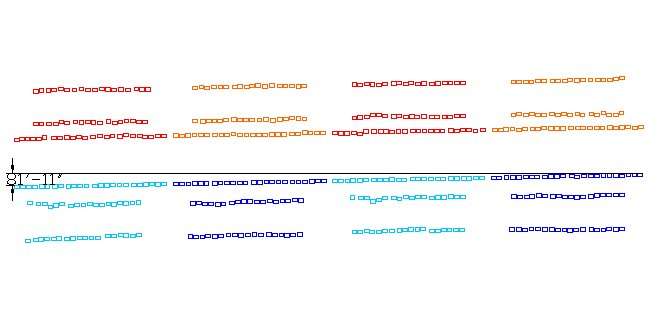 Even though the armies had been moving at only a march cadence and would have had the opportunity to dress their lines, it seems likely that there would still be unevenness in the alignment of the centuries. The total offset between the right and left sides is 82 feet. Here and there a century is shown as lagging behind the rest or having moved laterally. Unevenness in the ground would more than account for these small variances. All in all, the Frame 2 Revised is probably a more accurate representation of the army than Frame 2 was.
It is difficult to guess at just how uneven the lines may have been. The following image represents a much more disordered formation. Almost certainly some armies were disordered to this degree, some probably resembled the image above. This image is offered just as an example of how things might really have been in some cases. The rest of the model is based on the image above, not on this more staggered line formation.
Even though the armies had been moving at only a march cadence and would have had the opportunity to dress their lines, it seems likely that there would still be unevenness in the alignment of the centuries. The total offset between the right and left sides is 82 feet. Here and there a century is shown as lagging behind the rest or having moved laterally. Unevenness in the ground would more than account for these small variances. All in all, the Frame 2 Revised is probably a more accurate representation of the army than Frame 2 was.
It is difficult to guess at just how uneven the lines may have been. The following image represents a much more disordered formation. Almost certainly some armies were disordered to this degree, some probably resembled the image above. This image is offered just as an example of how things might really have been in some cases. The rest of the model is based on the image above, not on this more staggered line formation. 
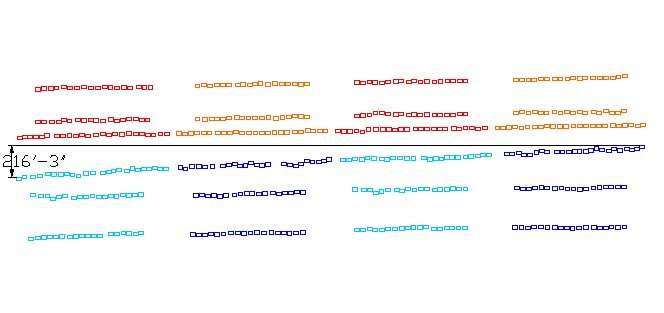 The gap that opens between the first and second lines in the Frame 3 illustration is over 200 feet, a bit further than would be appropriate if the second line was meant to actively support the first line. To remedy this the second line would have to run. That is illustrated in this frame.
The gap that opens between the first and second lines in the Frame 3 illustration is over 200 feet, a bit further than would be appropriate if the second line was meant to actively support the first line. To remedy this the second line would have to run. That is illustrated in this frame.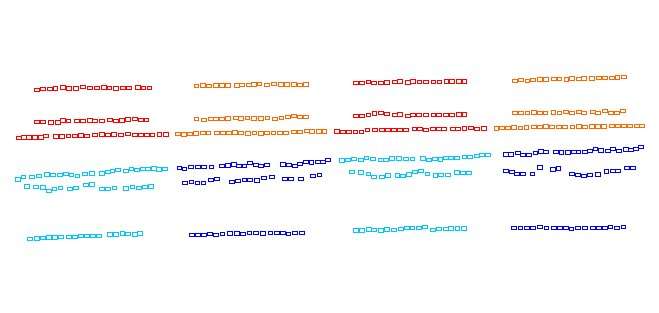 Line two now maintains a close relationship with line 1. Since it is running it also becomes disordered. Line 3 remains stationary and back almost 350 feet on the right side. At this stage of the illustrations, the red army is still shown in its previous position.
Line two now maintains a close relationship with line 1. Since it is running it also becomes disordered. Line 3 remains stationary and back almost 350 feet on the right side. At this stage of the illustrations, the red army is still shown in its previous position.
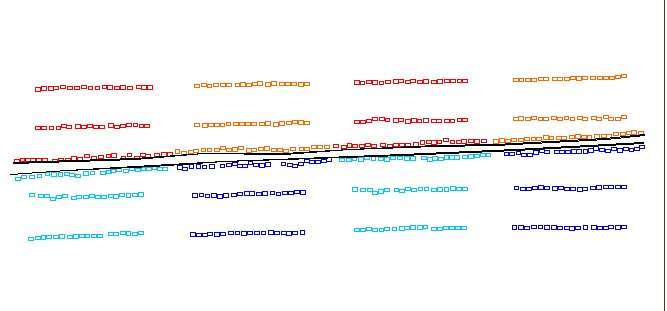 Two black lines have been added to show the general front for both charging lines. The distance between the two armies is not uniform. Some centuries are within pilum range and would release their pila, others would still need to run a few more steps. It could be expected that there would be a simultaneous throw by all members of a century but adjacent centuries would not be synchronized.
Frame 4 would be the general position from which the two armies would launch their pila. At this scale it is not possible to illustrate that. The next frame will jump to the moment of contact between the lines. In between these two frames we should imagine the events surrounding the pilum volley. If two ranks throw their pila that would be about 2,000 pila. There could be 300 to 400 dead and as many wounded falling among their comrades. As many as half the pila might fall short making a hedgerow of 1,000 pila to be negotiated between the two armies.
A general observation: One thing these drawings make clear is the complexity of trying to coordinate even four legions. The four-legion blue army has some 60 centuries to try to coordinate. As each one walks or runs into battle disorder along the line would be inevitable. It is likely that these illustrations understate the disorder.
Two black lines have been added to show the general front for both charging lines. The distance between the two armies is not uniform. Some centuries are within pilum range and would release their pila, others would still need to run a few more steps. It could be expected that there would be a simultaneous throw by all members of a century but adjacent centuries would not be synchronized.
Frame 4 would be the general position from which the two armies would launch their pila. At this scale it is not possible to illustrate that. The next frame will jump to the moment of contact between the lines. In between these two frames we should imagine the events surrounding the pilum volley. If two ranks throw their pila that would be about 2,000 pila. There could be 300 to 400 dead and as many wounded falling among their comrades. As many as half the pila might fall short making a hedgerow of 1,000 pila to be negotiated between the two armies.
A general observation: One thing these drawings make clear is the complexity of trying to coordinate even four legions. The four-legion blue army has some 60 centuries to try to coordinate. As each one walks or runs into battle disorder along the line would be inevitable. It is likely that these illustrations understate the disorder.
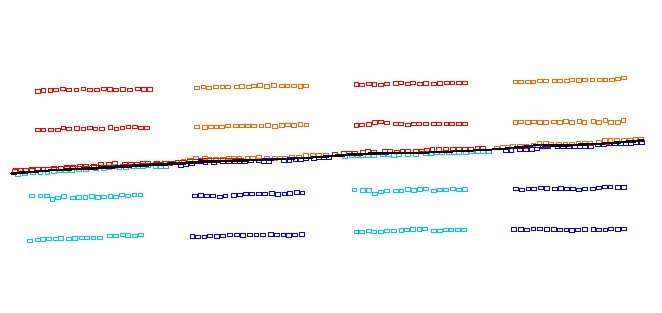 Aside from the fact that the line of battle (the dark line) is somewhat slanted and a bit uneven, this image does not appear all that different from what one might find in any book. It is when one begins to look more closely at the details that the true differences are apparent.
The enlarged circle in the illustration below shows some of these differences.
Aside from the fact that the line of battle (the dark line) is somewhat slanted and a bit uneven, this image does not appear all that different from what one might find in any book. It is when one begins to look more closely at the details that the true differences are apparent.
The enlarged circle in the illustration below shows some of these differences.
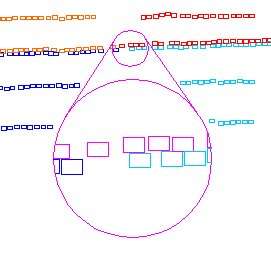 The first thing to note is the gap between the blue centuries. This gap is one of many along the line. They are inevitable. In the understated degree of disorder shown in these models, the gaps are relatively modest, usually less than 100 feet (the gap shown is 72 feet). They could just as well be several hundred feet. Their existence forces the question: what needs to be done about them? Can they be left there? Do the adjacent centuries spread out to fill the gaps? Do centuries from the second line step forward?
Another problem element is the fact that the centuries do not meet up exactly. On paper, they always line up nicely. But as the models show, as soon as one introduces some random movement along the line the centuries no longer meet so precisely.
One red century faces no one at all. What should this century be doing? Would it dare enter the gap? Would it attack the flanks of the two blue centuries? Would it shift to one side to link up with an adjacent century, leaving a wide gap in the line?
Two of the blue centuries are only partially engaged with the enemy.
The first thing to note is the gap between the blue centuries. This gap is one of many along the line. They are inevitable. In the understated degree of disorder shown in these models, the gaps are relatively modest, usually less than 100 feet (the gap shown is 72 feet). They could just as well be several hundred feet. Their existence forces the question: what needs to be done about them? Can they be left there? Do the adjacent centuries spread out to fill the gaps? Do centuries from the second line step forward?
Another problem element is the fact that the centuries do not meet up exactly. On paper, they always line up nicely. But as the models show, as soon as one introduces some random movement along the line the centuries no longer meet so precisely.
One red century faces no one at all. What should this century be doing? Would it dare enter the gap? Would it attack the flanks of the two blue centuries? Would it shift to one side to link up with an adjacent century, leaving a wide gap in the line?
Two of the blue centuries are only partially engaged with the enemy.
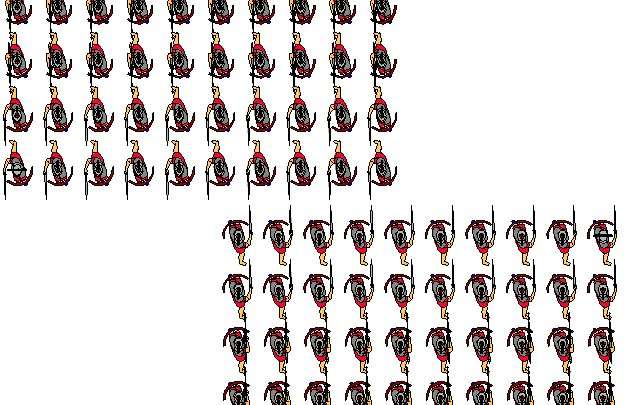 How should we imagine these centuries that only partially overlap each other? In the illustration on the right, both centurions on the right side of the centuries are facing empty space. What would they be doing? Would they just stand there while the left half of their formations are fighting? Would they perform a miniature flanking move and try to attack the sides of the enemy centuries?
One is tempted to say that the two centuries would take care of the problem during the charge phase; they would adjust their positions to line up against the enemy. But in the real world, this might not be possible for any number of reasons. Terrain features might force a century to veer from its chosen course. Adjacent centuries might be out of their alignment, forcing other centuries out of position. Or, by the time the centurions became aware that they would not meet an enemy century head on it would be too late to adjust the running charge of their men.
These are the kinds of questions the model raises, and for which there are no ready answers. A complete model of how the Roman army fought should be able to explain all of these questions. I am not aware of any model that addresses, much less answers, questions of this nature.
How should we imagine these centuries that only partially overlap each other? In the illustration on the right, both centurions on the right side of the centuries are facing empty space. What would they be doing? Would they just stand there while the left half of their formations are fighting? Would they perform a miniature flanking move and try to attack the sides of the enemy centuries?
One is tempted to say that the two centuries would take care of the problem during the charge phase; they would adjust their positions to line up against the enemy. But in the real world, this might not be possible for any number of reasons. Terrain features might force a century to veer from its chosen course. Adjacent centuries might be out of their alignment, forcing other centuries out of position. Or, by the time the centurions became aware that they would not meet an enemy century head on it would be too late to adjust the running charge of their men.
These are the kinds of questions the model raises, and for which there are no ready answers. A complete model of how the Roman army fought should be able to explain all of these questions. I am not aware of any model that addresses, much less answers, questions of this nature.
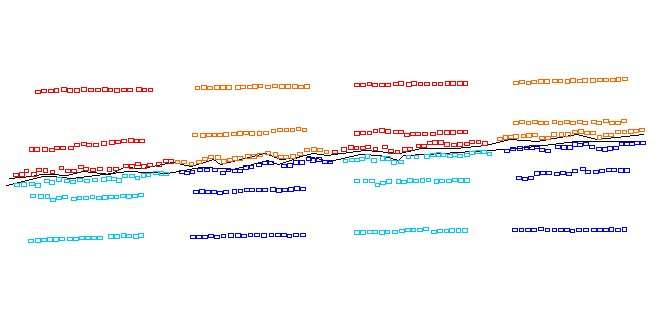 If the two sides are well-matched both may fall back evenly. Otherwise, one side will fall back leaving the other side in possession of the line. This creates a yet more jagged line of battle. Gaps increase, new gaps appear. Weaker units fall well back of the stronger, more aggressive units. Distances between the lines are not uniform with some units remaining closer to the enemy than others. The entire battlefield becomes more chaotic.
If the two sides are well-matched both may fall back evenly. Otherwise, one side will fall back leaving the other side in possession of the line. This creates a yet more jagged line of battle. Gaps increase, new gaps appear. Weaker units fall well back of the stronger, more aggressive units. Distances between the lines are not uniform with some units remaining closer to the enemy than others. The entire battlefield becomes more chaotic.
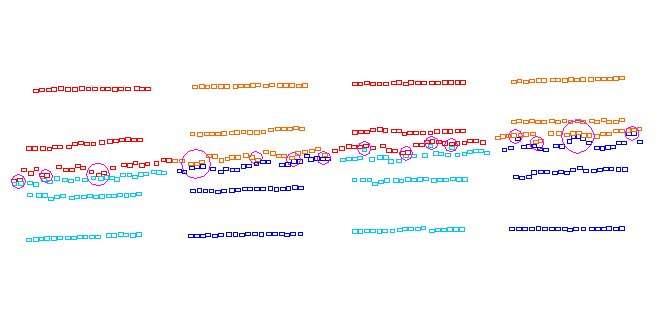 In the illustration above I show 15 local attacks (the circles). Most are by one century, several (the larger circles) are by a couple of centuries cooperating.
The illustration may give the impression that all 15 attacks would be simultaneous. That is not the case. They would happen as each unit worked up the enthusiasm for it. At any given moment there might be none, one or many local attacks happening along the line.
When a century ventured across the 60 feet of space to attack the enemy its flanks would be unprotected. What should we imagine the centuries on either side of it doing? Would they move forward to protect the flanks? Would they be emboldened to attack also? Or would they hold their place in line, perhaps still too tired or frightened to move? The illustration has some flanking centuries joining in the attack, some moving forward a bit, others remaining in place.
When a century launched an attack the enemy century could either stand its ground to receive it or run forward to meet it. Both cases are shown in the illustration above. Wherever the centuries meet in the middle of the open space the two sides have both charged. In other cases, one side or the other was the aggressor and one side more passive in accepting the charge.
In the illustration above I show 15 local attacks (the circles). Most are by one century, several (the larger circles) are by a couple of centuries cooperating.
The illustration may give the impression that all 15 attacks would be simultaneous. That is not the case. They would happen as each unit worked up the enthusiasm for it. At any given moment there might be none, one or many local attacks happening along the line.
When a century ventured across the 60 feet of space to attack the enemy its flanks would be unprotected. What should we imagine the centuries on either side of it doing? Would they move forward to protect the flanks? Would they be emboldened to attack also? Or would they hold their place in line, perhaps still too tired or frightened to move? The illustration has some flanking centuries joining in the attack, some moving forward a bit, others remaining in place.
When a century launched an attack the enemy century could either stand its ground to receive it or run forward to meet it. Both cases are shown in the illustration above. Wherever the centuries meet in the middle of the open space the two sides have both charged. In other cases, one side or the other was the aggressor and one side more passive in accepting the charge.
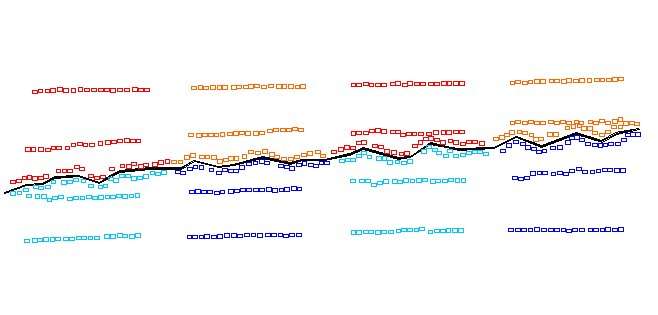 As the lines become more oblique the question arises of how the individual centuries along those oblique lines should be represented. In the illustrations above all of the centuries continue to face rigidly forward.
As the lines become more oblique the question arises of how the individual centuries along those oblique lines should be represented. In the illustrations above all of the centuries continue to face rigidly forward.
 In reality, if they are fighting along a slanting line would the centuries continue to face straight ahead but angle their fronts to match? In the illustration on the left, the two centuries on the bottom retain the traditional rectangular arrangement. The two at the top have angled their ranks to align with the actual front (red line).
Neither formation seems completely acceptable.
In reality, if they are fighting along a slanting line would the centuries continue to face straight ahead but angle their fronts to match? In the illustration on the left, the two centuries on the bottom retain the traditional rectangular arrangement. The two at the top have angled their ranks to align with the actual front (red line).
Neither formation seems completely acceptable.
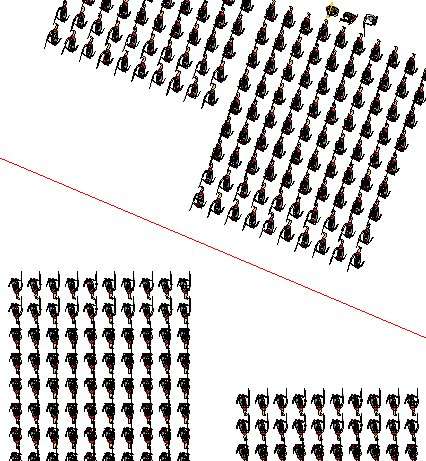 In the illustration on the right, the bottom centuries continue to keep the standard rectangular formation, the two on the top keep the rank and file formation but have angled it to face the front (red line.)
In some ways, the angled formation seems better but if the entire battle line were re-oriented for every jog it would be exceedingly chaotic.
There is not really a question of what the individual soldiers did. They would surely face directly into the enemy soldiers. Rather, the question is how did the century arrange itself? Did it even attempt to keep its ranks and files? Probably, most evidence seems to place some importance on maintaining them.
All in all, the least unsatisfactory solution is to have the centuries continue in the traditional fashion -- rectangular rank and file formation facing forward as in the illustration below.
In the illustration on the right, the bottom centuries continue to keep the standard rectangular formation, the two on the top keep the rank and file formation but have angled it to face the front (red line.)
In some ways, the angled formation seems better but if the entire battle line were re-oriented for every jog it would be exceedingly chaotic.
There is not really a question of what the individual soldiers did. They would surely face directly into the enemy soldiers. Rather, the question is how did the century arrange itself? Did it even attempt to keep its ranks and files? Probably, most evidence seems to place some importance on maintaining them.
All in all, the least unsatisfactory solution is to have the centuries continue in the traditional fashion -- rectangular rank and file formation facing forward as in the illustration below.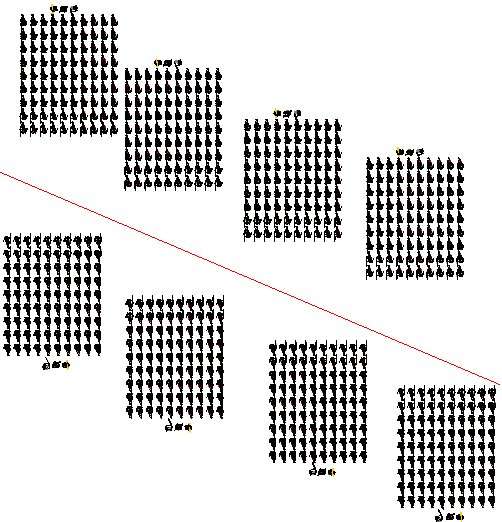
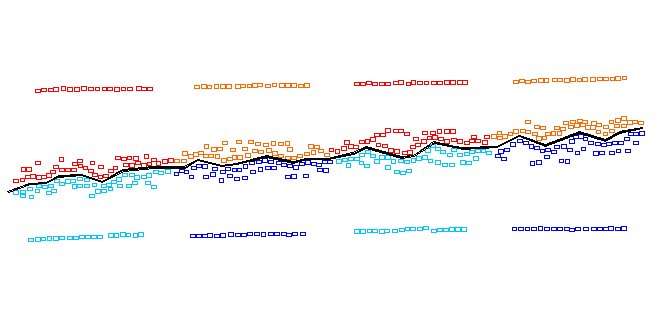 Certainly one activity during the lulls would be the reinforcement of the front line. The second line could move into any gaps that had opened in the fighting. It could also reinforce units that had been pushed back or handled roughly in the engagements. This is what is shown in the illustration above.
The dead, both friendly and enemy, could be removed so that they would not be obstacles. The friendly wounded could be removed for cares. Enemy wounded may have simply been killed. The battlefield could be further cleaned up by the removal of abandoned equipment. Usable pila or other missile weapons could be gathered up.
Lulls in the fighting would also provide an opportunity to bring water to the front. Much of ancient warfare took place in the summer, under the Mediterranean sun, in hot dry dusty conditions. Even if the individual soldiers had wished to be encumbered by water skins, they could probably not have carried enough to fully meet their needs over an extended battle.
One might imagine legion slaves, skirmishers or other reserve personnel moving back and forth between the rear supply area and the front lines -- bringing water and supplies forward, taking wounded back.
The lulls were also a time of fighting. Both Sabin and Zhmodikov would have the two sides engaging in missile warfare during this period. This may, in fact, have been one of the main activities during the lulls.
How might the century have thrown their remaining pila?
Certainly one activity during the lulls would be the reinforcement of the front line. The second line could move into any gaps that had opened in the fighting. It could also reinforce units that had been pushed back or handled roughly in the engagements. This is what is shown in the illustration above.
The dead, both friendly and enemy, could be removed so that they would not be obstacles. The friendly wounded could be removed for cares. Enemy wounded may have simply been killed. The battlefield could be further cleaned up by the removal of abandoned equipment. Usable pila or other missile weapons could be gathered up.
Lulls in the fighting would also provide an opportunity to bring water to the front. Much of ancient warfare took place in the summer, under the Mediterranean sun, in hot dry dusty conditions. Even if the individual soldiers had wished to be encumbered by water skins, they could probably not have carried enough to fully meet their needs over an extended battle.
One might imagine legion slaves, skirmishers or other reserve personnel moving back and forth between the rear supply area and the front lines -- bringing water and supplies forward, taking wounded back.
The lulls were also a time of fighting. Both Sabin and Zhmodikov would have the two sides engaging in missile warfare during this period. This may, in fact, have been one of the main activities during the lulls.
How might the century have thrown their remaining pila?
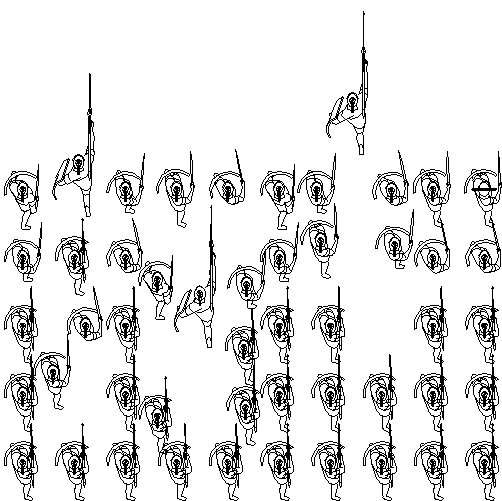 The image to the right shows a century in the stand-off position, about 60 feet from the enemy line. Three different scenarios for how they might throw pila at the enemy are shown. From left to right:
In the first example, the swordsmen of the first two ranks have moved back to ranks 3 and 4, allowing soldiers armed with pila to move to the front. In this way, the century could utilize all of its men, bring fresh men into the front rank for fighting, and make use of all of their pila.
The second scenario shows a soldier in the third rank throwing his pilum up over the heads of those in the front rank. Everyone around him has moved aside to give him room to move. This has the advantage of retaining a shield wall along the front.
The third scenario shows a soldier from the third rank running through a gap in the files to advance out in front of the formation to throw his pilum. This shortens the distance he has to throw. It also preserves the integrity of the first two lines. If the best fighters were initially placed in those lines then there may have been an advantage to not rotating the ranks.
The image to the right shows a century in the stand-off position, about 60 feet from the enemy line. Three different scenarios for how they might throw pila at the enemy are shown. From left to right:
In the first example, the swordsmen of the first two ranks have moved back to ranks 3 and 4, allowing soldiers armed with pila to move to the front. In this way, the century could utilize all of its men, bring fresh men into the front rank for fighting, and make use of all of their pila.
The second scenario shows a soldier in the third rank throwing his pilum up over the heads of those in the front rank. Everyone around him has moved aside to give him room to move. This has the advantage of retaining a shield wall along the front.
The third scenario shows a soldier from the third rank running through a gap in the files to advance out in front of the formation to throw his pilum. This shortens the distance he has to throw. It also preserves the integrity of the first two lines. If the best fighters were initially placed in those lines then there may have been an advantage to not rotating the ranks.
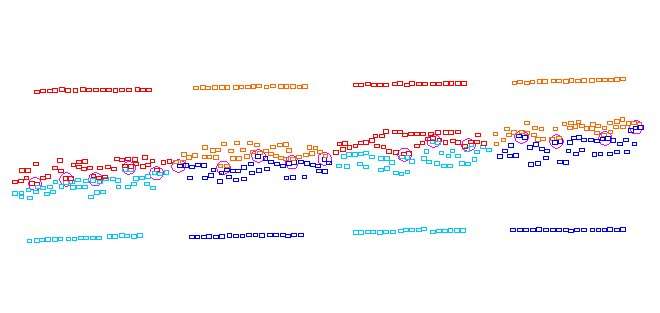
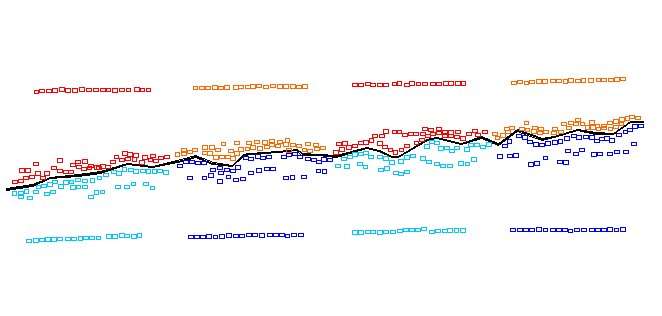
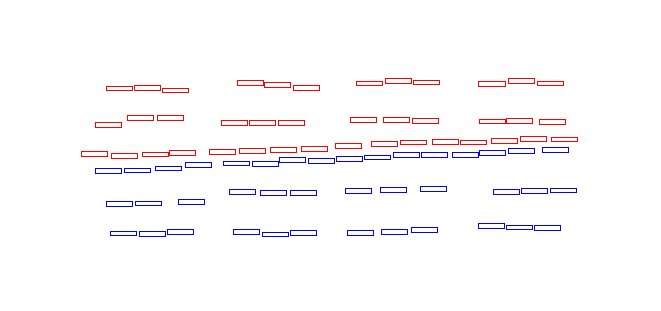 However, while this model might be somewhat different from the century models above there would still be confusion along the line. Centuries would still need space between them because they would veer off-course when attacking. The line would still become jagged as one part was pushed back and another surged forward. Gaps between centuries or cohorts would be opened as the lines salients developed. It would still have been important to maintain some type of integrity of the battleline.
The key to understanding how the army described by Caesar functioned may not be so much in the physical arrangement as in the communications. Cohorts and legions could respond as cohesive units, almost regardless of their physical deployment, if there were adequate communications. The aeneator assigned to each century is probably the key figure. He could relay command signals from the tribunes of the legion. As is clear from the passages quoted above, the men were trained to stay with their standards. When the aeneator blew a signal and the signifer moved the standards the century was supposed to follow. Coordinating the activities of the legion would, then, be primarily a matter of ensuring that the appropriate orders were relayed to each of the cohorts and centuries.
However, while this model might be somewhat different from the century models above there would still be confusion along the line. Centuries would still need space between them because they would veer off-course when attacking. The line would still become jagged as one part was pushed back and another surged forward. Gaps between centuries or cohorts would be opened as the lines salients developed. It would still have been important to maintain some type of integrity of the battleline.
The key to understanding how the army described by Caesar functioned may not be so much in the physical arrangement as in the communications. Cohorts and legions could respond as cohesive units, almost regardless of their physical deployment, if there were adequate communications. The aeneator assigned to each century is probably the key figure. He could relay command signals from the tribunes of the legion. As is clear from the passages quoted above, the men were trained to stay with their standards. When the aeneator blew a signal and the signifer moved the standards the century was supposed to follow. Coordinating the activities of the legion would, then, be primarily a matter of ensuring that the appropriate orders were relayed to each of the cohorts and centuries.
 The illustration below shows the spacing between the centuries. Prior and Posterior pairs of centuries are separated by six feet, pairs of centuries are separated from each other by twice that, twelve feet, and legions are separated by fifty feet. These separations are arbitrary and largely there for manoeuvre. As will be seen, once combat begins these spacings become irrelevant.
The illustration below shows the spacing between the centuries. Prior and Posterior pairs of centuries are separated by six feet, pairs of centuries are separated from each other by twice that, twelve feet, and legions are separated by fifty feet. These separations are arbitrary and largely there for manoeuvre. As will be seen, once combat begins these spacings become irrelevant. Every other legion in each army is a slightly different colour. This was done merely to help distinguish one legion from the next and has no other significance.
Why four legions? Although armies of this era were often larger than four legions, it would be too time-consuming to try to draw them with this level of detail. And, even if they were drawn, the final images would be so wide that details could not be seen. I selected four because it makes for an army that is large enough to give an idea of what the battlefield might have been like and small enough to be drafted and for details to be visible.
Every other legion in each army is a slightly different colour. This was done merely to help distinguish one legion from the next and has no other significance.
Why four legions? Although armies of this era were often larger than four legions, it would be too time-consuming to try to draw them with this level of detail. And, even if they were drawn, the final images would be so wide that details could not be seen. I selected four because it makes for an army that is large enough to give an idea of what the battlefield might have been like and small enough to be drafted and for details to be visible. The two armies have moved to 300 feet (about 100 meters) from each other.
It is just possible that the two armies paused at this position while the generals prepared the soldiers for combat. In the narrative of Pharsalus, Caesar talked to the centurion Crastinus who promised a good fight and then immediately ran forward into battle. If that happened as narrated then the two armies could not have been much further apart than shown above.
This is a good place to discuss another feature of ancient battles, the tendency of armies to advance on the right more than on the left and even to shift slightly in that direction. This is attributed to the individual's desire to shelter behind his neighbour's shield on his right side. Apparently, this was the case with nearly all ancient armies.
How much shift? This is one of those areas for which there is no information. And no right answer, for each army in each battle would have been different. Nevertheless, to put it into the model some numbers have to be used. It would not take much to create the offset. If each man held back just one inch behind the man to his right the total offset for the four-legion army shown above would be 80 feet. Since the two armies are only 300 feet apart that is a significant distance.
The next image shows the armies in the same position as the one above but this time with the shift in the lines represented.
The two armies have moved to 300 feet (about 100 meters) from each other.
It is just possible that the two armies paused at this position while the generals prepared the soldiers for combat. In the narrative of Pharsalus, Caesar talked to the centurion Crastinus who promised a good fight and then immediately ran forward into battle. If that happened as narrated then the two armies could not have been much further apart than shown above.
This is a good place to discuss another feature of ancient battles, the tendency of armies to advance on the right more than on the left and even to shift slightly in that direction. This is attributed to the individual's desire to shelter behind his neighbour's shield on his right side. Apparently, this was the case with nearly all ancient armies.
How much shift? This is one of those areas for which there is no information. And no right answer, for each army in each battle would have been different. Nevertheless, to put it into the model some numbers have to be used. It would not take much to create the offset. If each man held back just one inch behind the man to his right the total offset for the four-legion army shown above would be 80 feet. Since the two armies are only 300 feet apart that is a significant distance.
The next image shows the armies in the same position as the one above but this time with the shift in the lines represented. Even though the armies had been moving at only a march cadence and would have had the opportunity to dress their lines, it seems likely that there would still be unevenness in the alignment of the centuries. The total offset between the right and left sides is 82 feet. Here and there a century is shown as lagging behind the rest or having moved laterally. Unevenness in the ground would more than account for these small variances. All in all, the Frame 2 Revised is probably a more accurate representation of the army than Frame 2 was.
It is difficult to guess at just how uneven the lines may have been. The following image represents a much more disordered formation. Almost certainly some armies were disordered to this degree, some probably resembled the image above. This image is offered just as an example of how things might really have been in some cases. The rest of the model is based on the image above, not on this more staggered line formation.
Even though the armies had been moving at only a march cadence and would have had the opportunity to dress their lines, it seems likely that there would still be unevenness in the alignment of the centuries. The total offset between the right and left sides is 82 feet. Here and there a century is shown as lagging behind the rest or having moved laterally. Unevenness in the ground would more than account for these small variances. All in all, the Frame 2 Revised is probably a more accurate representation of the army than Frame 2 was.
It is difficult to guess at just how uneven the lines may have been. The following image represents a much more disordered formation. Almost certainly some armies were disordered to this degree, some probably resembled the image above. This image is offered just as an example of how things might really have been in some cases. The rest of the model is based on the image above, not on this more staggered line formation. 
Frame 3: The blue army charges
In the following image, the blue army is shown at the point where it would be ready to launch the pilum volley. The red army is not shown as moving in this image for the sake of clarity. In the previous image, the armies were about 300 feet apart. Both will be shown running together so that each will run about 150 feet. In this frame, the blue army is at pilum distance from the red. The right-wing of the blue army is shown as having run about 175 feet. The gap that opens between the first and second lines in the Frame 3 illustration is over 200 feet, a bit further than would be appropriate if the second line was meant to actively support the first line. To remedy this the second line would have to run. That is illustrated in this frame.
The gap that opens between the first and second lines in the Frame 3 illustration is over 200 feet, a bit further than would be appropriate if the second line was meant to actively support the first line. To remedy this the second line would have to run. That is illustrated in this frame. Line two now maintains a close relationship with line 1. Since it is running it also becomes disordered. Line 3 remains stationary and back almost 350 feet on the right side. At this stage of the illustrations, the red army is still shown in its previous position.
Line two now maintains a close relationship with line 1. Since it is running it also becomes disordered. Line 3 remains stationary and back almost 350 feet on the right side. At this stage of the illustrations, the red army is still shown in its previous position.
Frame 4: The red army also charges
Returning to the blue position in Frame 3 (not Frame 3 Alt) the red army is now also shown in its charging position. Two black lines have been added to show the general front for both charging lines. The distance between the two armies is not uniform. Some centuries are within pilum range and would release their pila, others would still need to run a few more steps. It could be expected that there would be a simultaneous throw by all members of a century but adjacent centuries would not be synchronized.
Frame 4 would be the general position from which the two armies would launch their pila. At this scale it is not possible to illustrate that. The next frame will jump to the moment of contact between the lines. In between these two frames we should imagine the events surrounding the pilum volley. If two ranks throw their pila that would be about 2,000 pila. There could be 300 to 400 dead and as many wounded falling among their comrades. As many as half the pila might fall short making a hedgerow of 1,000 pila to be negotiated between the two armies.
A general observation: One thing these drawings make clear is the complexity of trying to coordinate even four legions. The four-legion blue army has some 60 centuries to try to coordinate. As each one walks or runs into battle disorder along the line would be inevitable. It is likely that these illustrations understate the disorder.
Two black lines have been added to show the general front for both charging lines. The distance between the two armies is not uniform. Some centuries are within pilum range and would release their pila, others would still need to run a few more steps. It could be expected that there would be a simultaneous throw by all members of a century but adjacent centuries would not be synchronized.
Frame 4 would be the general position from which the two armies would launch their pila. At this scale it is not possible to illustrate that. The next frame will jump to the moment of contact between the lines. In between these two frames we should imagine the events surrounding the pilum volley. If two ranks throw their pila that would be about 2,000 pila. There could be 300 to 400 dead and as many wounded falling among their comrades. As many as half the pila might fall short making a hedgerow of 1,000 pila to be negotiated between the two armies.
A general observation: One thing these drawings make clear is the complexity of trying to coordinate even four legions. The four-legion blue army has some 60 centuries to try to coordinate. As each one walks or runs into battle disorder along the line would be inevitable. It is likely that these illustrations understate the disorder.
Frame 5: Collision of the two armies
This illustration shows the two lines coming together. Aside from the fact that the line of battle (the dark line) is somewhat slanted and a bit uneven, this image does not appear all that different from what one might find in any book. It is when one begins to look more closely at the details that the true differences are apparent.
The enlarged circle in the illustration below shows some of these differences.
Aside from the fact that the line of battle (the dark line) is somewhat slanted and a bit uneven, this image does not appear all that different from what one might find in any book. It is when one begins to look more closely at the details that the true differences are apparent.
The enlarged circle in the illustration below shows some of these differences.
 The first thing to note is the gap between the blue centuries. This gap is one of many along the line. They are inevitable. In the understated degree of disorder shown in these models, the gaps are relatively modest, usually less than 100 feet (the gap shown is 72 feet). They could just as well be several hundred feet. Their existence forces the question: what needs to be done about them? Can they be left there? Do the adjacent centuries spread out to fill the gaps? Do centuries from the second line step forward?
Another problem element is the fact that the centuries do not meet up exactly. On paper, they always line up nicely. But as the models show, as soon as one introduces some random movement along the line the centuries no longer meet so precisely.
One red century faces no one at all. What should this century be doing? Would it dare enter the gap? Would it attack the flanks of the two blue centuries? Would it shift to one side to link up with an adjacent century, leaving a wide gap in the line?
Two of the blue centuries are only partially engaged with the enemy.
The first thing to note is the gap between the blue centuries. This gap is one of many along the line. They are inevitable. In the understated degree of disorder shown in these models, the gaps are relatively modest, usually less than 100 feet (the gap shown is 72 feet). They could just as well be several hundred feet. Their existence forces the question: what needs to be done about them? Can they be left there? Do the adjacent centuries spread out to fill the gaps? Do centuries from the second line step forward?
Another problem element is the fact that the centuries do not meet up exactly. On paper, they always line up nicely. But as the models show, as soon as one introduces some random movement along the line the centuries no longer meet so precisely.
One red century faces no one at all. What should this century be doing? Would it dare enter the gap? Would it attack the flanks of the two blue centuries? Would it shift to one side to link up with an adjacent century, leaving a wide gap in the line?
Two of the blue centuries are only partially engaged with the enemy.
 How should we imagine these centuries that only partially overlap each other? In the illustration on the right, both centurions on the right side of the centuries are facing empty space. What would they be doing? Would they just stand there while the left half of their formations are fighting? Would they perform a miniature flanking move and try to attack the sides of the enemy centuries?
One is tempted to say that the two centuries would take care of the problem during the charge phase; they would adjust their positions to line up against the enemy. But in the real world, this might not be possible for any number of reasons. Terrain features might force a century to veer from its chosen course. Adjacent centuries might be out of their alignment, forcing other centuries out of position. Or, by the time the centurions became aware that they would not meet an enemy century head on it would be too late to adjust the running charge of their men.
These are the kinds of questions the model raises, and for which there are no ready answers. A complete model of how the Roman army fought should be able to explain all of these questions. I am not aware of any model that addresses, much less answers, questions of this nature.
How should we imagine these centuries that only partially overlap each other? In the illustration on the right, both centurions on the right side of the centuries are facing empty space. What would they be doing? Would they just stand there while the left half of their formations are fighting? Would they perform a miniature flanking move and try to attack the sides of the enemy centuries?
One is tempted to say that the two centuries would take care of the problem during the charge phase; they would adjust their positions to line up against the enemy. But in the real world, this might not be possible for any number of reasons. Terrain features might force a century to veer from its chosen course. Adjacent centuries might be out of their alignment, forcing other centuries out of position. Or, by the time the centurions became aware that they would not meet an enemy century head on it would be too late to adjust the running charge of their men.
These are the kinds of questions the model raises, and for which there are no ready answers. A complete model of how the Roman army fought should be able to explain all of these questions. I am not aware of any model that addresses, much less answers, questions of this nature.
Frame 6: Fall back 60 feet
After a brief period of sword fighting the two sides fall back some distance. For these models that distance is taken to be about 60 feet. If the two sides are well-matched both may fall back evenly. Otherwise, one side will fall back leaving the other side in possession of the line. This creates a yet more jagged line of battle. Gaps increase, new gaps appear. Weaker units fall well back of the stronger, more aggressive units. Distances between the lines are not uniform with some units remaining closer to the enemy than others. The entire battlefield becomes more chaotic.
If the two sides are well-matched both may fall back evenly. Otherwise, one side will fall back leaving the other side in possession of the line. This creates a yet more jagged line of battle. Gaps increase, new gaps appear. Weaker units fall well back of the stronger, more aggressive units. Distances between the lines are not uniform with some units remaining closer to the enemy than others. The entire battlefield becomes more chaotic.
Frame 7: Sporadic local attacks
After some period of time in the fall-back position, local units mount another attack. Sabin, one of the main proponents of this model, seems to think that it would have happened at the level of the century. The attacks would have been initiated by the centurion or other natural fighter who would rally the men to make the sally. The attacks would not be orchestrated by any central command. In the illustration above I show 15 local attacks (the circles). Most are by one century, several (the larger circles) are by a couple of centuries cooperating.
The illustration may give the impression that all 15 attacks would be simultaneous. That is not the case. They would happen as each unit worked up the enthusiasm for it. At any given moment there might be none, one or many local attacks happening along the line.
When a century ventured across the 60 feet of space to attack the enemy its flanks would be unprotected. What should we imagine the centuries on either side of it doing? Would they move forward to protect the flanks? Would they be emboldened to attack also? Or would they hold their place in line, perhaps still too tired or frightened to move? The illustration has some flanking centuries joining in the attack, some moving forward a bit, others remaining in place.
When a century launched an attack the enemy century could either stand its ground to receive it or run forward to meet it. Both cases are shown in the illustration above. Wherever the centuries meet in the middle of the open space the two sides have both charged. In other cases, one side or the other was the aggressor and one side more passive in accepting the charge.
In the illustration above I show 15 local attacks (the circles). Most are by one century, several (the larger circles) are by a couple of centuries cooperating.
The illustration may give the impression that all 15 attacks would be simultaneous. That is not the case. They would happen as each unit worked up the enthusiasm for it. At any given moment there might be none, one or many local attacks happening along the line.
When a century ventured across the 60 feet of space to attack the enemy its flanks would be unprotected. What should we imagine the centuries on either side of it doing? Would they move forward to protect the flanks? Would they be emboldened to attack also? Or would they hold their place in line, perhaps still too tired or frightened to move? The illustration has some flanking centuries joining in the attack, some moving forward a bit, others remaining in place.
When a century launched an attack the enemy century could either stand its ground to receive it or run forward to meet it. Both cases are shown in the illustration above. Wherever the centuries meet in the middle of the open space the two sides have both charged. In other cases, one side or the other was the aggressor and one side more passive in accepting the charge.
Frame 8: fall back #2
By the second cycle of attack and fall-back, the battle line becomes even more jagged. More jagged, therefore longer. Gaps begin to appear all along the lines. As the lines become more oblique the question arises of how the individual centuries along those oblique lines should be represented. In the illustrations above all of the centuries continue to face rigidly forward.
As the lines become more oblique the question arises of how the individual centuries along those oblique lines should be represented. In the illustrations above all of the centuries continue to face rigidly forward.
 In reality, if they are fighting along a slanting line would the centuries continue to face straight ahead but angle their fronts to match? In the illustration on the left, the two centuries on the bottom retain the traditional rectangular arrangement. The two at the top have angled their ranks to align with the actual front (red line).
Neither formation seems completely acceptable.
In reality, if they are fighting along a slanting line would the centuries continue to face straight ahead but angle their fronts to match? In the illustration on the left, the two centuries on the bottom retain the traditional rectangular arrangement. The two at the top have angled their ranks to align with the actual front (red line).
Neither formation seems completely acceptable.
 In the illustration on the right, the bottom centuries continue to keep the standard rectangular formation, the two on the top keep the rank and file formation but have angled it to face the front (red line.)
In some ways, the angled formation seems better but if the entire battle line were re-oriented for every jog it would be exceedingly chaotic.
There is not really a question of what the individual soldiers did. They would surely face directly into the enemy soldiers. Rather, the question is how did the century arrange itself? Did it even attempt to keep its ranks and files? Probably, most evidence seems to place some importance on maintaining them.
All in all, the least unsatisfactory solution is to have the centuries continue in the traditional fashion -- rectangular rank and file formation facing forward as in the illustration below.
In the illustration on the right, the bottom centuries continue to keep the standard rectangular formation, the two on the top keep the rank and file formation but have angled it to face the front (red line.)
In some ways, the angled formation seems better but if the entire battle line were re-oriented for every jog it would be exceedingly chaotic.
There is not really a question of what the individual soldiers did. They would surely face directly into the enemy soldiers. Rather, the question is how did the century arrange itself? Did it even attempt to keep its ranks and files? Probably, most evidence seems to place some importance on maintaining them.
All in all, the least unsatisfactory solution is to have the centuries continue in the traditional fashion -- rectangular rank and file formation facing forward as in the illustration below.
Frame 9: Activity during the second lull
During the periods of lulls, a number of things could have been going on. The illustration below shows the second line closing up on the first line and filling in the gaps where necessary. Certainly one activity during the lulls would be the reinforcement of the front line. The second line could move into any gaps that had opened in the fighting. It could also reinforce units that had been pushed back or handled roughly in the engagements. This is what is shown in the illustration above.
The dead, both friendly and enemy, could be removed so that they would not be obstacles. The friendly wounded could be removed for cares. Enemy wounded may have simply been killed. The battlefield could be further cleaned up by the removal of abandoned equipment. Usable pila or other missile weapons could be gathered up.
Lulls in the fighting would also provide an opportunity to bring water to the front. Much of ancient warfare took place in the summer, under the Mediterranean sun, in hot dry dusty conditions. Even if the individual soldiers had wished to be encumbered by water skins, they could probably not have carried enough to fully meet their needs over an extended battle.
One might imagine legion slaves, skirmishers or other reserve personnel moving back and forth between the rear supply area and the front lines -- bringing water and supplies forward, taking wounded back.
The lulls were also a time of fighting. Both Sabin and Zhmodikov would have the two sides engaging in missile warfare during this period. This may, in fact, have been one of the main activities during the lulls.
How might the century have thrown their remaining pila?
Certainly one activity during the lulls would be the reinforcement of the front line. The second line could move into any gaps that had opened in the fighting. It could also reinforce units that had been pushed back or handled roughly in the engagements. This is what is shown in the illustration above.
The dead, both friendly and enemy, could be removed so that they would not be obstacles. The friendly wounded could be removed for cares. Enemy wounded may have simply been killed. The battlefield could be further cleaned up by the removal of abandoned equipment. Usable pila or other missile weapons could be gathered up.
Lulls in the fighting would also provide an opportunity to bring water to the front. Much of ancient warfare took place in the summer, under the Mediterranean sun, in hot dry dusty conditions. Even if the individual soldiers had wished to be encumbered by water skins, they could probably not have carried enough to fully meet their needs over an extended battle.
One might imagine legion slaves, skirmishers or other reserve personnel moving back and forth between the rear supply area and the front lines -- bringing water and supplies forward, taking wounded back.
The lulls were also a time of fighting. Both Sabin and Zhmodikov would have the two sides engaging in missile warfare during this period. This may, in fact, have been one of the main activities during the lulls.
How might the century have thrown their remaining pila?
 The image to the right shows a century in the stand-off position, about 60 feet from the enemy line. Three different scenarios for how they might throw pila at the enemy are shown. From left to right:
In the first example, the swordsmen of the first two ranks have moved back to ranks 3 and 4, allowing soldiers armed with pila to move to the front. In this way, the century could utilize all of its men, bring fresh men into the front rank for fighting, and make use of all of their pila.
The second scenario shows a soldier in the third rank throwing his pilum up over the heads of those in the front rank. Everyone around him has moved aside to give him room to move. This has the advantage of retaining a shield wall along the front.
The third scenario shows a soldier from the third rank running through a gap in the files to advance out in front of the formation to throw his pilum. This shortens the distance he has to throw. It also preserves the integrity of the first two lines. If the best fighters were initially placed in those lines then there may have been an advantage to not rotating the ranks.
The image to the right shows a century in the stand-off position, about 60 feet from the enemy line. Three different scenarios for how they might throw pila at the enemy are shown. From left to right:
In the first example, the swordsmen of the first two ranks have moved back to ranks 3 and 4, allowing soldiers armed with pila to move to the front. In this way, the century could utilize all of its men, bring fresh men into the front rank for fighting, and make use of all of their pila.
The second scenario shows a soldier in the third rank throwing his pilum up over the heads of those in the front rank. Everyone around him has moved aside to give him room to move. This has the advantage of retaining a shield wall along the front.
The third scenario shows a soldier from the third rank running through a gap in the files to advance out in front of the formation to throw his pilum. This shortens the distance he has to throw. It also preserves the integrity of the first two lines. If the best fighters were initially placed in those lines then there may have been an advantage to not rotating the ranks.
Frame 10: Local attack #2
This frame shows 17 local attacks. By this point, the second line is almost indistinguishable from the first line in some places.
Frame 11: Fall back #3
This is the final frame in this sequence. Presumably the cycles of local attacks and withdrawals could continue for hours. Victory might be decided if one side were to break through the formation at some point. More often victory seems to have been associated with flank attacks, sometimes by infantry, often by cavalry.
Defects in the 11 frame sequence
The sequence shown in the 11 frames above is incomplete. At best it gives a way to visualize some of the ideas of Sabin and Zhmodikov. In reality it probably raises more questions than it answers. The role of the second line is poorly understood, and therefore not well represented in the drawings. Sabin suggests a dogtooth pattern so that the second line of cohorts have open gaps in front of them and simply move forward to fill those gaps. The frame sequence does not show the second line in this role for a number of reasons. In part, because the dogtooth formation would make the entire legion front rather wide. But also, in part, because I personally find the idea of gaps difficult to accept. In one respect the Sabin formation is not radically different from what was shown here. If the cohorts of the second line move forward to fill the gaps then the result is one long line of cohorts, much like what was shown here (except somewhat longer) if you eliminate line two. If the role of the second line is poorly understood, the role of the third line is not understood at all. That is why it never moves. It acted as a strategic reserve, most say. In the scenario outlined above there is no occasion for utilizing a strategic reserve so the line is stationary. In reality, though, the line almost certainly had some function and the 30% of the army that it represented would surely have been put to some use. At this time, however, I simply do not know how to show that line in action. The scenario is also incomplete in that it shows only four legions of infantry fighting against each other. It does not try to depict Roman against some other type of army. It does not include skirmishers or cavalry units. Both armies are identical, no consideration is given to uneven sizes of armies. Nor does the scenario really take casualties into account -- either in the impact they might have had by impeding movement on the field of battle or the effect of losing men on the units. Despite these defects the 11 frame scenario does make an effort to depict the sporadic hand-to-hand fighting and lulls in battle that Sabin and Zhmodikov have shown to be an intrinsic part of Roman warfare. They also try to show the confusion of battle, the loss of organization, and the jumbled jagged battle lines that must surely have resulted.A clearer understanding of the Roman fighting technique
Here and there Caesar makes a comments that can help us better understand just how the legion fought. In De Bello Galico [DBG 2.23 ff] Caesar describes an surprise attack on the legions while they were setting up camp. He notes that the 9th and 10th legions, on the left, drove the enemy back over a creek. On the right was the 12th legion and not far from it, the 7th [ et non magno ab ea intervallo VII]. As the battle progressed things initially went poorly for the Romans. The 9th and 10th pursued too far leaving the center open. The 12th got itself bunched up and was unable to fight effectively. All of the centurions of the 4th cohort had been killed [quartae cohortis omnibus centurionibus occisis]. In a famous passage he ordered that the standards be moved so that the battle line could be opened up more [cohortatus milites signa inferre et manipulos laxare iussit, quo facilius gladiis uti possent]. At one point Caesar orders the 7th and 12th legions to come together [paulatim sese legiones coniungerent]. And Labienus, seeing the difficulty on the right, sent the 10th legion over to help out [X legionem subsidio nostris misit]. In this battle, at least, there was a wide gap in the center between the two pairs of legions. The 12th legion was able to re-organize itself during battle by moving the standards which the men were able to follow. If all of the centurions in the 4th cohort were killed then all of those six centuries were in action (possibly an argument in favor of the centuries being side by side). The 7th legion was near the 12th, literally "not much of a interval from it." Later they were ordered to coniungere, to join together; apparently they were separated by a significant distance. Labienus is able to completely re-direct the 10th legion right during battle. [DBG 5.15 ff] Caesar describes an action in Britain where he sent two cohorts to defend the army that was being harassed while on the march. These two cohorts positioned themselves close to each other [cum hae perexiguo intermisso loci spatio inter se constitissent] but apparently left somewhat of a gap that the enemy was able to escape through [per medios audacissime perruperunt]. Even a fighting group as small as two cohorts left something of a gap between them -- enough that the enemy could escape through it. [DBG 5.35] Caesar describes an action in which a part of his force was cornered. In this narrative he mentions individual cohorts trying to break out of the encirclement and launch an attack [cum quaepiam cohors ex orbe excesserat atque impetum fecerat]. Cohorts were capable of independent coordinated action. [DBG 7.62] In one of Labienus' fights the tribunes of the 7th legion which was on the right were told about events on the left; the tribunes turned the legion around to attack the enemy rear [cum septimae legionis tribunis esset nuntiatum quae in sinistro cornu gererentur, post tergum hostium legionem ostenderunt signaque intulerunt]. The tribunes received information during the battle and were able to ... ostendere is a difficult verb. Literally it means to show or display, to present. In this case it seems to mean that the legion somehow moved to present itself to the back of the enemy force. They key element here is that, again, a legion was able to maneuver as a cohesive body during battle and at the command of its tribunes. [DBC 3.89] At Pharsalus Caesar notes that the 8th and 9th legions were under strength so he put them close together as to almost make a single legion of them and ordered them to assist each other [et huic sic adiunxit octavam, ut paene unam ex duabus efficeret, atque alteram alteri praesidio esse iusserat]. The two legions are specifically joined together -- adiungere, to join to. The implication is that otherwise they would have fought apart or independently from each other. These ideas are somewhat different from the scenario described above. The main difficulty is that the scenarios are based on centuries undertaking independent action. After a very short time the entire line of battle becomes a jumble of centuries with no discernible structure. This would seem to fly in the face of Caesar's remarks about cohort and legion cohesion. A model can be developed in which cohorts are the smallest independent units. It might look something like this (a cohort version of Frame 4 above) However, while this model might be somewhat different from the century models above there would still be confusion along the line. Centuries would still need space between them because they would veer off-course when attacking. The line would still become jagged as one part was pushed back and another surged forward. Gaps between centuries or cohorts would be opened as the lines salients developed. It would still have been important to maintain some type of integrity of the battleline.
The key to understanding how the army described by Caesar functioned may not be so much in the physical arrangement as in the communications. Cohorts and legions could respond as cohesive units, almost regardless of their physical deployment, if there were adequate communications. The aeneator assigned to each century is probably the key figure. He could relay command signals from the tribunes of the legion. As is clear from the passages quoted above, the men were trained to stay with their standards. When the aeneator blew a signal and the signifer moved the standards the century was supposed to follow. Coordinating the activities of the legion would, then, be primarily a matter of ensuring that the appropriate orders were relayed to each of the cohorts and centuries.
However, while this model might be somewhat different from the century models above there would still be confusion along the line. Centuries would still need space between them because they would veer off-course when attacking. The line would still become jagged as one part was pushed back and another surged forward. Gaps between centuries or cohorts would be opened as the lines salients developed. It would still have been important to maintain some type of integrity of the battleline.
The key to understanding how the army described by Caesar functioned may not be so much in the physical arrangement as in the communications. Cohorts and legions could respond as cohesive units, almost regardless of their physical deployment, if there were adequate communications. The aeneator assigned to each century is probably the key figure. He could relay command signals from the tribunes of the legion. As is clear from the passages quoted above, the men were trained to stay with their standards. When the aeneator blew a signal and the signifer moved the standards the century was supposed to follow. Coordinating the activities of the legion would, then, be primarily a matter of ensuring that the appropriate orders were relayed to each of the cohorts and centuries.
